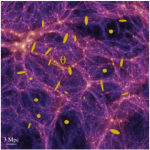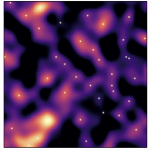The phenomenon of light deflection in the presence of massive objects is denoted as gravitational lensing. On extra-galactic scales, galaxies, clusters of galaxies, and even the filamentary structure of the cosmic web act as gravitational lenses. The tidal fields of those mass distributions cause images of high-redshift galaxies to be distorted. If the distortions are very small, they cannot be detected on individual galaxies, but only statistically, by averaging over a large number of galaxies, we speak of weak lensing.

Non-Gaussian structures
On small scales, the structures of the cosmic web are non-Gaussian. This information is not captured by traditional second-order statistics such as the weak-lensing two-point correlation function or power spectrum. Peaks in weak-lensing maps, defined as local maxima of the lensing convergence, are tracers of over-dense regions, and provide a means to extract higher-order, non-Gaussian information. Lin & Kilbinger (2015) devised a new model for WL peaks, that was studied in further publications. [Click here for more].

